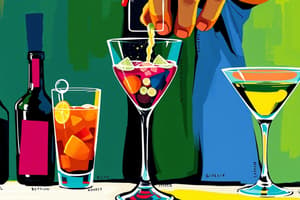Podcast
Questions and Answers
What technique in mixology is specifically used to release flavors from herbs or fruits?
What technique in mixology is specifically used to release flavors from herbs or fruits?
- Stirring
- Shaking
- Muddling (correct)
- Layering
Which cocktail is primarily made with tequila?
Which cocktail is primarily made with tequila?
- Mojito
- Margarita (correct)
- Martini
- Old Fashioned
What is the primary purpose of a jigger in mixology?
What is the primary purpose of a jigger in mixology?
- To strain drinks
- To muddle ingredients
- To shake cocktails
- To measure alcohol portions (correct)
Which mixology style is characterized by innovative ingredients and techniques?
Which mixology style is characterized by innovative ingredients and techniques?
What is the importance of balancing sweetness, acidity, and bitterness in cocktails?
What is the importance of balancing sweetness, acidity, and bitterness in cocktails?
Which tool is used to separate ice from a drink when pouring?
Which tool is used to separate ice from a drink when pouring?
When engaging with customers about their drink preferences, which aspect is NOT typically emphasized?
When engaging with customers about their drink preferences, which aspect is NOT typically emphasized?
What type of garnishes can enhance both the presentation and flavor of a cocktail?
What type of garnishes can enhance both the presentation and flavor of a cocktail?
Which component is essential for creating distinct layers in a cocktail?
Which component is essential for creating distinct layers in a cocktail?
Which of the following is NOT a commonly used spirit in cocktails?
Which of the following is NOT a commonly used spirit in cocktails?
Flashcards are hidden until you start studying
Study Notes
Definition
- Mixology is the art and science of crafting cocktails and mixed drinks.
Key Concepts
- Ingredients: Understanding various spirits (vodka, gin, rum, tequila, whiskey), liqueurs, bitters, and mixers (juices, sodas, syrups).
- Techniques:
- Shaking: Mixing ingredients vigorously with ice to chill and aerate.
- Stirring: Combining ingredients gently to maintain clarity and balance.
- Muddling: Pressing herbs or fruits to release flavors.
- Layering: Pouring ingredients slowly to create distinct layers in a drink.
Essential Tools
- Shaker: Used for shaking cocktails, usually a Boston shaker or cobbler shaker.
- Strainer: Tool to separate ice from the drink when pouring.
- Jigger: Measuring device for precise alcohol portions.
- Muddler: Used to mash ingredients for flavor extraction.
Popular Cocktails
- Mojito: Rum, mint, lime juice, sugar, soda water.
- Martini: Gin (or vodka), vermouth, olive/lemon twist.
- Old Fashioned: Whiskey, sugar, bitters, orange twist.
- Margarita: Tequila, lime juice, triple sec, salt rim.
Mixology Styles
- Classic: Focuses on traditional recipes and techniques.
- Modern: Incorporates innovative ingredients, techniques, and presentation.
- Molecular: Uses scientific methods to create unique textures and flavors.
Flavor Profiles
- Balance: Importance of balancing sweetness, acidity, bitterness, and strength.
- Complementary Flavors: Combining flavors that enhance each other (e.g., citrus with herbs).
Garnishes
- Enhances presentation and flavor; includes fruits, herbs, spices, and edible flowers.
Bar Setup
- Well-Stocked Bar: Essential spirits, mixers, and tools readily available.
- Organization: Efficient layout to streamline the mixing process.
Customer Interaction
- Understanding Preferences: Engaging with customers to determine their tastes.
- Presentation: Importance of aesthetics in serving drinks.
Safety and Responsibility
- Alcohol Awareness: Understanding limits and responsible service.
- Legal Age: Ensuring compliance with local alcohol laws and regulations.
Definition
- Mixology combines art and science to create exceptional cocktails and mixed drinks.
Key Concepts
- Ingredients: Knowledge of various spirits (vodka, gin, rum, tequila, whiskey), liqueurs, bitters, and mixers (juices, sodas, syrups) is essential to mixology.
- Techniques:
- Shaking: Technique to chill and aerate drinks by mixing vigorously with ice.
- Stirring: Gentle combination of ingredients to preserve clarity and balance.
- Muddling: Pressing herbs or fruits to extract and enhance flavors.
- Layering: Method of slowly pouring ingredients to create visually distinct layers.
Essential Tools
- Shaker: A Boston or cobbler shaker is vital for combining cocktail ingredients.
- Strainer: Separates ice from drinks during pouring for a smooth finish.
- Jigger: A precise measuring tool to ensure accurate alcohol portions.
- Muddler: Used for mashing ingredients to release their flavors.
Popular Cocktails
- Mojito: Contains rum, mint, lime juice, sugar, and soda water for a refreshing taste.
- Martini: Traditional cocktail made with gin (or vodka) and vermouth, garnished with an olive or lemon twist.
- Old Fashioned: A classic drink featuring whiskey, sugar, bitters, and an orange twist for flavor.
- Margarita: Combines tequila, lime juice, and triple sec, often served with a salt rim.
Mixology Styles
- Classic: Centers on timeless recipes and traditional mixing techniques.
- Modern: Embraces innovative ingredients and new mixing methods for contemporary drinks.
- Molecular: Explores scientific techniques to create novel textures and flavors in cocktails.
Flavor Profiles
- Balance: Achieving a harmonious mix of sweetness, acidity, bitterness, and strength is crucial for satisfying cocktails.
- Complementary Flavors: Enhancing a drink by pairing flavors that work well together, such as citrus and herbs.
Garnishes
- Used to improve the presentation and aroma of drinks; options include fruits, herbs, spices, and edible flowers.
Bar Setup
- Well-Stocked Bar: A good bar should have essential spirits, mixers, and tools easily accessible for efficient mixing.
- Organization: A well-organized layout improves speed and effectiveness in drink preparation.
Customer Interaction
- Understanding Preferences: Engaging with customers helps ascertain their tastes and provides a personalized experience.
- Presentation: Aesthetic appeal of drinks plays a significant role in customer satisfaction.
Safety and Responsibility
- Alcohol Awareness: Knowledge of personal limits and the importance of responsible serving practices.
- Legal Age: Adherence to local laws and regulations regarding the legal drinking age is mandatory for compliance.
Studying That Suits You
Use AI to generate personalized quizzes and flashcards to suit your learning preferences.




